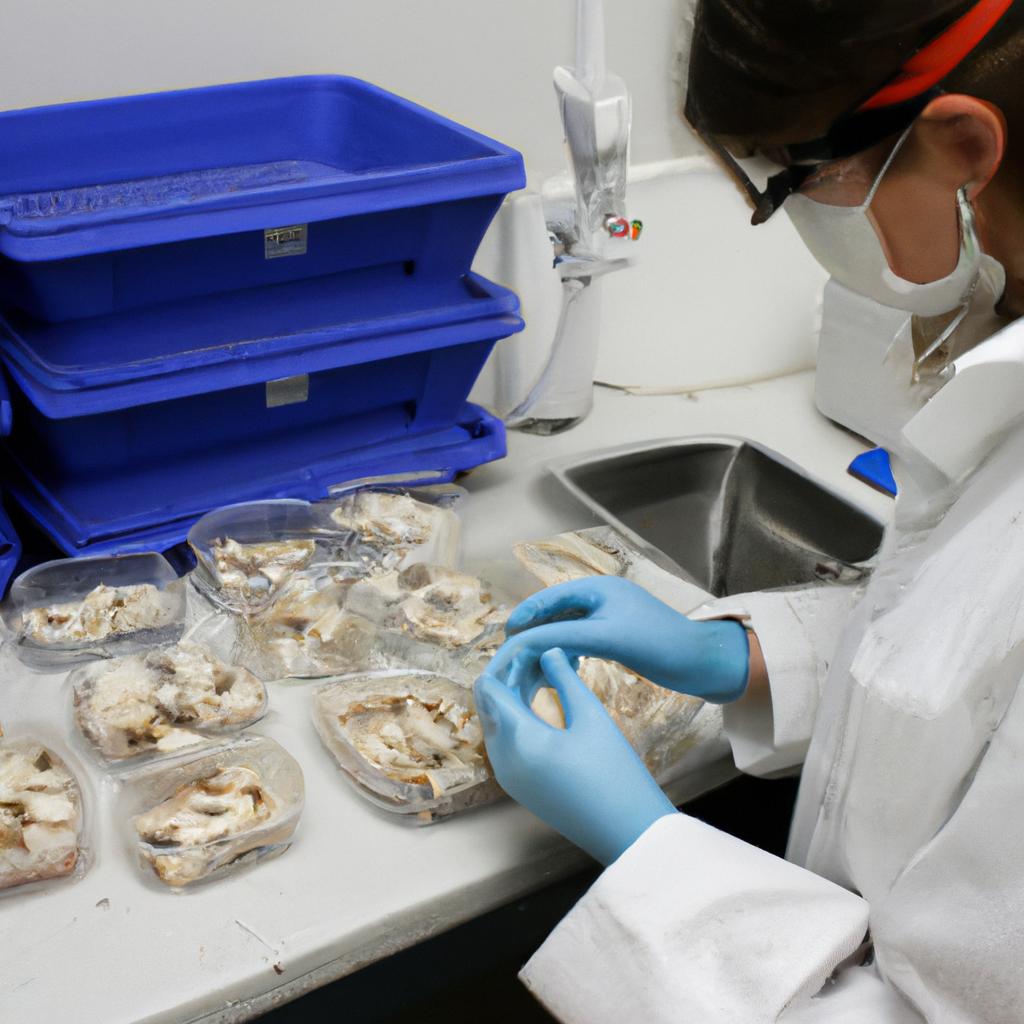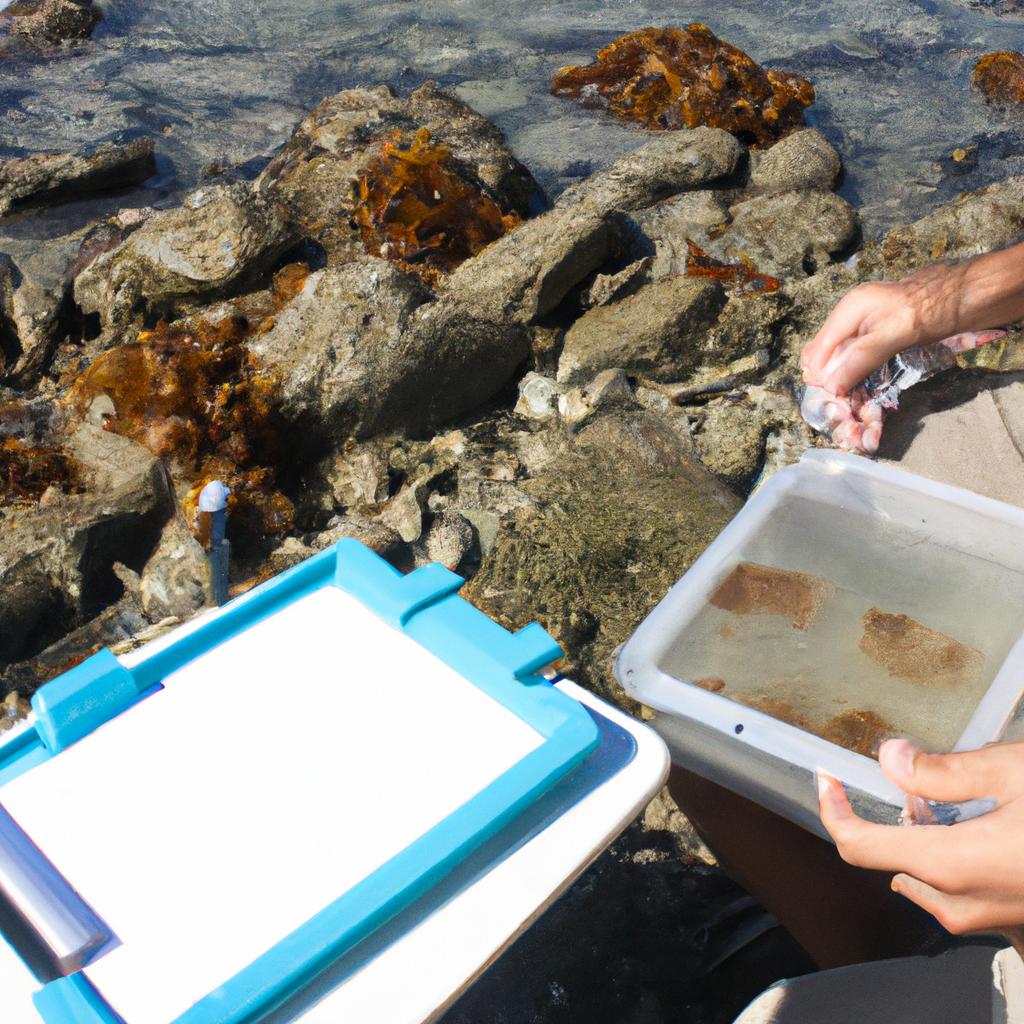The increasing levels of carbon dioxide emissions resulting from human activities have led to significant changes in the Earth’s climate system. One of the most concerning consequences is the process known as ocean acidification, which occurs when excess carbon dioxide dissolves into seawater and alters its chemistry. This phenomenon has far-reaching implications for marine ecosystems, particularly with regards to oxygen depletion. To illustrate this issue, let us consider a hypothetical scenario where excessive carbon dioxide emissions continue unabated: as more carbon dioxide enters the oceans, it reacts with water molecules, forming carbonic acid and reducing pH levels. The subsequent decrease in pH can hinder the ability of marine organisms to produce calcium carbonate structures such as shells and coral reefs, ultimately leading to a decline in their populations.
As ocean acidification progresses due to climate change, it poses severe threats to various forms of marine life dependent on dissolved oxygen availability. Oxygen depletion refers to the reduction in the concentration of dissolved oxygen within aquatic environments, significantly impacting both aerobic organisms that require oxygen for respiration and anaerobic species that rely on alternative metabolic processes. As atmospheric CO2 concentrations rise, so does its absorption by surface waters through chemical reactions. Consequently, high levels of dissolved CO2 negatively affect the solubility of oxygen in seawater and result in decreased oxygen availability for marine organisms.
This decrease in oxygen availability can lead to a variety of detrimental effects on marine ecosystems. For aerobic organisms such as fish, shellfish, and certain types of phytoplankton, low oxygen levels can impair their ability to carry out essential metabolic processes like growth, reproduction, and overall survival. These species may experience reduced population sizes or even die off in areas with severe oxygen depletion.
Moreover, oxygen depletion also affects anaerobic organisms that have adapted to live in environments without oxygen or with very low oxygen levels. These organisms rely on alternative metabolic processes such as fermentation or sulfur metabolism. However, when dissolved oxygen concentrations drop too low, even these adaptations may not be sufficient for their survival.
Additionally, the combination of ocean acidification and oxygen depletion can exacerbate the negative impacts on marine life. As pH levels decrease due to higher carbon dioxide concentrations in seawater, it becomes more challenging for marine organisms to regulate their physiological processes effectively. This includes maintaining proper ion balance and acid-base homeostasis within their bodies.
Overall, the consequences of ocean acidification and the resulting oxygen depletion are far-reaching and pose significant threats to marine ecosystems. It is crucial that efforts are made to reduce carbon dioxide emissions and mitigate climate change’s impact on our oceans to preserve the health and biodiversity of these vital ecosystems.
Rising greenhouse gas emissions
Rising Greenhouse Gas Emissions
The impact of rising greenhouse gas emissions on climate change is a pressing issue that has garnered significant attention in recent years. The accumulation of these gases, such as carbon dioxide (CO2), methane (CH4), and nitrous oxide (N2O), in the Earth’s atmosphere leads to increased global temperatures and subsequent changes in various ecosystems. One example of this can be seen in the alarming rise of ocean acidification due to elevated CO2 levels.
To illustrate the gravity of the situation, consider a hypothetical scenario where coastal communities heavily rely on fishing as their primary source of income. As greenhouse gas emissions continue to increase, leading to higher atmospheric concentrations of CO2, more carbon dioxide dissolves into seawater through a process known as oceanic absorption. This results in a decrease in pH levels within the marine environment, making it increasingly acidic over time. Such changes have detrimental effects on marine life, including shellfish and coral reefs which are highly sensitive to fluctuations in acidity levels.
The consequences of ocean acidification extend beyond ecological disruptions; they also carry economic and social implications for communities dependent on marine resources. A four-item bullet point list highlights some key impacts:
- Reduced fish populations
- Decline in seafood availability and quality
- Loss of livelihoods for fishermen
- Increased vulnerability for coastal communities
Moreover, we can visually represent the severity of these consequences by utilizing a three-column table with four rows:
| Impact | Description | Example |
|---|---|---|
| Ecological | Disruption of food chains | Coral bleaching |
| Economic | Decreased revenue from fisheries | Diminished demand for local seafood |
| Social | Job loss | Migration away from affected areas |
| Environmental | Shifting habitats | Decrease in biodiversity |
In conclusion, rising greenhouse gas emissions contribute significantly to the phenomenon of ocean acidification. The subsequent changes in pH levels have far-reaching consequences on marine ecosystems, posing threats to both ecological stability and human well-being. With this understanding established, it is vital to explore further how increased absorption of carbon dioxide exacerbates these challenges.
Transitioning into the next section about “Increased absorption of carbon dioxide,” we delve deeper into the processes that intensify ocean acidification and its implications for our planet’s delicate balance.
Increased absorption of carbon dioxide
Impact of Increased Absorption of Carbon Dioxide
This phenomenon not only exacerbates climate change but also contributes significantly to ocean acidification, presenting a range of detrimental effects on marine ecosystems.
One example that highlights the consequences of increased absorption is the case study conducted in the Great Barrier Reef. Researchers found that the excessive influx of carbon dioxide has caused significant damage to coral reefs, resulting in bleaching and reduced biodiversity within this iconic ecosystem. Such impacts are indicative of a much broader issue affecting countless other marine environments worldwide.
To fully comprehend the gravity of this problem, we must consider some key points:
- Reduced pH levels: The absorption of excess carbon dioxide results in decreased seawater pH levels, making it more acidic.
- Calcification inhibition: Higher acidity inhibits calcification processes, which are vital for shell-forming organisms such as oysters, clams, and corals.
- Disruption of food webs: Acidic waters can disrupt various stages of life cycles for many species, including planktonic organisms at the base of marine food chains.
- Impaired sensory perception: Some studies suggest that elevated CO2 levels may affect certain fish species’ olfactory systems, disrupting their ability to detect predators or locate prey effectively.
These concerning realities paint a vivid picture: ocean acidification poses serious threats to both individual species and entire ecosystems. To further illustrate these implications, refer to Table 1 below highlighting some major ecological changes observed due to increased CO2 absorption:
| Ecological Changes | Examples |
|---|---|
| Coral reef degradation | Bleaching events |
| Shellfish population decline | Decreased oyster harvests |
| Altered predator-prey dynamics | Disrupted feeding behavior |
| Losses in biodiversity | Decline in species richness |
The evidence presented here is a call to action. It emphasizes the urgent need for policies and practices that can mitigate greenhouse gas emissions, thereby reducing the impact of increased carbon dioxide absorption on our oceans. By understanding these ramifications, we can strive towards developing solutions that promote environmental sustainability and preserve the delicate balance within marine ecosystems.
Transitioning into the next section about “Formation of Carbonic Acid,” it becomes apparent that this process occurs due to chemical reactions brought forth by excessive CO2 dissolution in seawater.
Formation of carbonic acid
Impact of Increased Carbon Dioxide Absorption
This increased absorption is causing a significant shift in ocean chemistry, resulting in a process known as ocean acidification. To better understand the impact of this phenomenon, consider the hypothetical case study below:.
Case Study: Coral Reefs
Coral reefs are among the most diverse and productive ecosystems on Earth, providing habitat for countless marine species. However, they are particularly vulnerable to changes in seawater chemistry caused by elevated CO2 levels. As atmospheric CO2 continues to rise, more of it dissolves into the oceans, leading to an increase in hydrogen ions and subsequent decrease in pH.
The consequences of ocean acidification extend far beyond coral reefs alone. Here are some key implications that highlight the severity of this issue:
- Ecosystem Disruption: Ocean acidification poses a threat to various marine organisms such as shellfish, plankton, and certain types of algae. These organisms play crucial roles in food webs and provide sustenance for larger marine animals.
- Biodiversity Loss: The disruption of ecosystems ultimately leads to a decline in biodiversity. Many species rely on specific habitats or interact with other species dependent on stable pH levels; any disturbance can have cascading effects throughout entire ecosystems.
- Economic Consequences: Industries heavily reliant on healthy ocean ecosystems face potential economic losses. Fisheries could suffer from reduced fish populations or decreased quality due to weakened shells or skeletons caused by lower pH levels.
- Social Impact: Coastal communities whose livelihoods depend on fishing may experience job losses and economic instability if their local fisheries become compromised.
To further illustrate these implications visually, please refer to Table 1 below:
| Implication | Description |
|---|---|
| Ecosystem Disruption | Ocean acidification disrupts the ecological balance of marine ecosystems. |
| Biodiversity Loss | Decreased pH levels can lead to a decline in biodiversity within oceans. |
| Economic Consequences | Industries reliant on healthy ocean ecosystems may face economic losses. |
| Social Impact | Coastal communities dependent on fishing could experience job losses and more. |
Table 1: Implications of Ocean Acidification
In summary, the increased absorption of carbon dioxide by the oceans is causing significant changes in seawater chemistry, leading to ocean acidification. This phenomenon poses substantial threats to various marine organisms, ecosystems, economies, and coastal communities worldwide. The next section will delve into the direct consequences of this process by exploring reduced pH levels in the ocean.
Transition Sentence: Understanding the impact of reduced pH levels in the ocean helps shed light on the severity of consequences resulting from ocean acidification.
Reduced pH levels in the ocean
Impact of Ocean Acidification on Marine Ecosystems
The formation of carbonic acid due to increased levels of atmospheric carbon dioxide has led to a reduction in pH levels within the ocean. This decrease in pH, known as ocean acidification, poses significant challenges for marine organisms and ecosystems. To better understand the consequences of this phenomenon, let us consider an example: coral reefs.
Coral reefs are highly diverse and productive ecosystems that provide habitat for numerous species. When exposed to acidic conditions, the calcium carbonate structures formed by corals become vulnerable to dissolution. As a result, coral bleaching occurs, wherein corals lose their vibrant colors and algae symbionts due to stress-induced expulsion. This case study exemplifies the detrimental effects of ocean acidification on marine biodiversity.
To further illustrate the broader implications of ocean acidification, we can examine its impact through several key perspectives:
- Economic Consequences: Industries such as fishing and tourism heavily rely on healthy marine ecosystems. The degradation or loss of coral reefs affects these industries directly through reduced fish populations and decreased tourist attractions.
- Food Security: Many communities around the world depend on seafood as a primary source of protein. Diminished fish stocks resulting from ocean acidification could significantly undermine food security for coastal populations.
- Biodiversity Loss: Coral reefs support a vast array of species, including fishes, crustaceans, mollusks, and many others. Their decline would lead to substantial loss in overall marine biodiversity.
- Carbon Sequestration: Healthy oceans play a crucial role in absorbing large amounts of carbon dioxide from the atmosphere. However, ocean acidification compromises this function by reducing the ability of certain organisms like phytoplankton to absorb CO2 efficiently.
These points highlight just some of the ways in which ocean acidification can have profound impacts on both ecological systems and human societies alike.
In light of these concerns surrounding ocean acidification’s effect on marine ecosystems, it becomes crucial to examine the negative consequences that various organisms face as a result. Transitioning into the subsequent section on “Negative effects on marine life,” we will explore how different species are affected by this ongoing environmental change.
Negative effects on marine life
Reduced pH levels in the ocean have far-reaching consequences for marine life, ecosystems, and ultimately our planet’s well-being. As carbon dioxide (CO2) emissions continue to rise due to human activities, such as burning fossil fuels and deforestation, the absorption of CO2 by seawater leads to a process known as ocean acidification. This phenomenon not only alters the chemical composition of our oceans but also poses a significant threat to various organisms that rely on calcium carbonate structures for their survival.
Consider the case of coral reefs, one of Earth’s most diverse and vibrant ecosystems. These intricate underwater habitats provide shelter, food sources, and breeding grounds for countless species. However, with rising CO2 levels contributing to increased acidity in the water, corals struggle to build their calcium carbonate skeletons or even maintain existing ones. This inability has devastating consequences for both individual coral polyps and entire reef systems.
The negative effects of ocean acidification extend beyond coral reefs and impact a wide range of marine organisms. To further comprehend its implications, consider the following emotional bullet points:
- Increasing vulnerability: Many shell-forming organisms like oysters, clams, and sea snails face challenges in forming protective shells under acidic conditions.
- Disrupted food chains: The reduction in calcifying plankton populations affects larger animals dependent on them for sustenance.
- Altered behavior: Acidic waters can disrupt sensory cues used by fish and other marine creatures for navigation, feeding patterns, reproduction, and predator avoidance.
- Ecosystem collapse: The loss of key species due to acidification can trigger cascading effects throughout entire marine ecosystems.
To highlight some specific examples of vulnerable species affected by ocean acidification:
| Species | Vulnerability | Impacts |
|---|---|---|
| Coral Reefs | Extreme | Bleaching & habitat loss |
| Shellfish | High | Weakened shells |
| Pteropods | High | Dissolving exoskeletons |
| Clownfish | Moderate | Altered behavior |
These examples underscore the urgent need to address climate change and mitigate its effects, particularly ocean acidification. By understanding the consequences of reduced pH levels in our oceans, we can work towards developing sustainable practices that safeguard marine life and preserve these invaluable ecosystems.
Transitioning into the subsequent section about “Implications for global ecosystems,” it becomes imperative to recognize how the impacts of ocean acidification extend beyond individual species. The interconnectedness between various habitats and organisms emphasizes the urgency with which we must confront this issue head-on to protect not only marine life but also global ecosystems as a whole.
Implications for global ecosystems
Ocean acidification, a direct consequence of increasing levels of carbon dioxide in the atmosphere, poses significant threats to marine ecosystems worldwide. As discussed previously, the negative effects on marine life are already evident, but it is crucial to understand how these changes reverberate throughout global ecosystems.
One hypothetical example that illustrates the far-reaching implications of ocean acidification involves coral reefs. These delicate and biodiverse ecosystems provide habitats for countless species and act as natural barriers against coastal erosion. However, when exposed to excessive acidity, corals struggle to build their calcium carbonate skeletons. This weakens their structural integrity and makes them more susceptible to damage from storms and other disturbances. Consequently, entire reef systems can collapse, leading to devastating losses in biodiversity and disruption of essential ecological processes.
The implications of ocean acidification extend beyond individual species or localized areas; they have repercussions at a global scale:
- Impaired Food Chains: Ocean acidification affects primary producers such as phytoplankton and algae. Changes in pH disrupt their growth and productivity, which subsequently impacts higher trophic levels throughout food chains.
- Decreased Biodiversity: Many species rely on calcifying organisms like shellfish and corals for habitat or sustenance. Their decline due to reduced calcification rates could lead to imbalances within ecosystems and decreased overall diversity.
- Altered Biogeochemical Cycling: Oceans play a vital role in regulating Earth’s climate by absorbing carbon dioxide. However, increased acidity inhibits this process by reducing the capacity of seawater to absorb excess CO2 effectively.
- Economic Consequences: Industries reliant on fisheries or tourism related to healthy marine environments may experience financial losses as ocean acidification disrupts key ecosystem services.
To further illustrate the potential consequences across various ecosystems, consider Table 1 below:
Table 1: Examples of Impacts from Ocean Acidification Across Different Ecosystems
| Ecosystem | Impact |
|---|---|
| Coral Reefs | Reduced coral growth and increased vulnerability to damage |
| Kelp Forests | Impaired development of kelp structures and decreased biodiversity |
| Estuaries | Decline in shell-forming species and altered nutrient cycling |
| Open Ocean | Disruption of phytoplankton communities and weakened food chains |
These examples highlight the breadth of potential consequences resulting from ocean acidification. It is essential for scientists, policymakers, and society as a whole to recognize these risks and take action towards mitigating climate change.
In summary, ocean acidification poses significant threats to marine ecosystems globally. The hypothetical example of coral reefs illustrates how this phenomenon can lead to ecosystem collapse with far-reaching consequences. From impaired food chains to economic impacts, the implications are widespread. Recognizing the range of effects across different ecosystems emphasizes the need for urgent measures to combat climate change and protect our oceans’ delicate balance.




